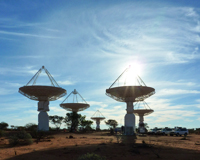CASDA prepares for ASKAP data
17 July 2014
Individuals from CSIRO’s Astronomy and Space Science (CASS) and Information Management & Technology (IM&T), along with staff from iVEC's Pawsey Centre, are working together to develop and build the CSIRO ASKAP Science Data Archive (CASDA).
CASDA is one of three subsystems, with the Telescope Operating System (TOS) and the Central Processor, which form the core component of ASKAP computing. CASDA is the primary point for storing, managing and sharing fully calibrated and science-ready data products. It will also provide the ASKAP Survey Science Teams with access to processed data products for analysis.
Since the CASDA project began almost a year ago, the team has been working on confirming system requirements, while simultaneously designing and verifying the proposed system architecture. With initial results already looking promising, the team is now preparing to build a data archive system that will be able to face the ‘wave’ of data produced by ASKAP, as well as the challenge of how to store it.
“We’re looking at up to 16 terabytes of ASKAP data coming into the archive per day, with storage of up to five petabytes of ASKAP observation data per year”, says Jessica Chapman, CASDA project leader.
ASKAP data will be stored at the iVEC Pawsey Centre in Perth. In addition to satisfying the real-time processing needs of ASKAP, the Pawsey Centre also provides archival storage via hierarchical storage management (HSM) software coupled with tape storage.
The first stage deployment of the archive has sufficient capacity to support two years of observing with ASKAP. In the future, this capacity may be expanded to support the continued growth of the ASKAP archive.
The immediate objectives for the team now include:
- Building the initial working version of the CASDA system.
- Carrying out extensive end-user testing of CASDA by working with a selected group of science users; this will include evaluation of components and sub-systems and testing of CASDA as an end-to-end system.
- Providing a functional and well-tested system to support ASKAP Early Science.
The primary outcome of the CASDA project is increased radio-astronomy research being undertaken using ASKAP as part of the Australia Telescope National Facility. Aside from radio astronomy, supercomputing resources at iVEC's Pawsey Centre will also be available for data-intensive projects across the scientific spectrum, including biotechnology, geosciences and nanotechnology.
Back to Latest ASKAP News page.

